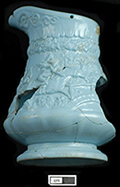How to Determine Production Methods
Press molded ceramics were formed by pressing sheets of clay into molds. Separate pieces of the mold were then connected and the seams in the clay joined and smoothed.
Slip casting was made when a liquid clay slip was poured into the plaster mold. After the clay closest to the mold had dried, the excess liquid slip was poured away. The dried clay pieces were removed from the molds, trimmed and joined to form vessels.
To easily tell the difference in vessels created by these two manufacturing techniques, look at the vessel interior. A press molded ceramic will have a smooth or relatively smooth interior, while the interior of a slip cast vessel will follow the relief design on the exterior.
The jug shown at left depicts the Tam O’Shanter pattern, based on a famous poem by Scottish poet Robert Burns. Impressed in the base of the jug are the words “Published by W. Ridgway & Co., Hanley, October 1st, 1835”. The designs on the jug were based on a series of engravings by Thomas Landseer for the 1830 edition of Tam O’Shanter (Henrywood 1984:66). This jug, whose shape is characteristic of the earliest press molded jugs, was recovered from 18BC27, the site of the Federal Reserve Bank in Baltimore. It had been deposited in a circular brick-lined privy along with a number of other ceramic and glass vessels that suggested the privy had been filled sometime between 1835 and 1870.
